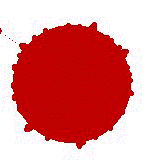Blood Cell Types
|
 |
Structure & Function |
Think about it - O"I was about 47 when I collapsed one day at work. There are 22 minutes of my life that I don't remember. I had gone into cardiac arrest." Fortunately he received prompt treatment and had successful heart surgery. He continued to life a fairly normal life, and even ran the Boston Marathon. But more than 1/3 of the 1.2 million Americans who suffer a heart attack each year don't make it. This grim evidence shows that the heart and circulatory system it powers are vital to life. Why is that so?
![]() Key Questions Include:
Key Questions Include:
What are the functions of the circulatory system?
How does the heart pump blood through the body?
What are three types of blood vessels?
What is the function of each component in blood?
What is the function of the lymphatic system?
What are three common circulatory diseases?
What is the connection between cholesterol and circulatory disease?
What is the function of the respiratory system?
How are oxygen and carbon dioxide exchanged and transported through the body?
What mechanisms are involved in breathing?
How does smoking affect the respiratory system?Active Art: The Heart
Active Art: Breathing
SciLinks: Cardiovascular System
SciLinks: Blood Cells
In the Blood
At the age of 60, John underwent surgery to reroute blood around blocked vessels in his heart. SInce then, he has limited his fat intake and stuckk to an exercise program. Still, today he is meeting with his doctor to talk about a new medication that would break up fatty deposits re-forming in his heart's vessels.
Click Here for the complete Chapter Mystery

What is a Heart Attack?
(from the NIH)









